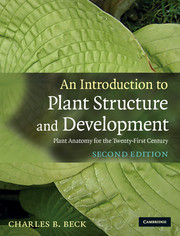Book contents
- Frontmatter
- Contents
- Preface to the second edition
- Preface
- Acknowledgements
- General references
- Chapter 1 Problems of adaptation to a terrestrial environment
- Chapter 2 An overview of plant structure and development
- Chapter 3 The protoplast of the eukaryotic cell
- Chapter 4 Structure and development of the cell wall
- Chapter 5 Meristems of the shoot and their role in plant growth and development
- Chapter 6 Morphology and development of the primary vascular system of the stem
- Chapter 7 Sympodial systems and patterns of nodal anatomy
- Chapter 8 The epidermis
- Chapter 9 The origin of secondary tissue systems and the effect of their formation on the primary body in seed plants
- Chapter 10 The vascular cambium: structure and function
- Chapter 11 Secondary xylem
- Chapter 12 The phloem
- Chapter 13 Periderm, rhytidome, and the nature of bark
- Chapter 14 Unusual features of structure and development in stems and roots
- Chapter 15 Secretion in plants
- Chapter 16 The root
- Chapter 17 The leaf
- Chapter 18 Reproduction and the origin of the sporophyte
- Glossary
- Index
- References
Chapter 8 - The epidermis
Published online by Cambridge University Press: 05 June 2012
- Frontmatter
- Contents
- Preface to the second edition
- Preface
- Acknowledgements
- General references
- Chapter 1 Problems of adaptation to a terrestrial environment
- Chapter 2 An overview of plant structure and development
- Chapter 3 The protoplast of the eukaryotic cell
- Chapter 4 Structure and development of the cell wall
- Chapter 5 Meristems of the shoot and their role in plant growth and development
- Chapter 6 Morphology and development of the primary vascular system of the stem
- Chapter 7 Sympodial systems and patterns of nodal anatomy
- Chapter 8 The epidermis
- Chapter 9 The origin of secondary tissue systems and the effect of their formation on the primary body in seed plants
- Chapter 10 The vascular cambium: structure and function
- Chapter 11 Secondary xylem
- Chapter 12 The phloem
- Chapter 13 Periderm, rhytidome, and the nature of bark
- Chapter 14 Unusual features of structure and development in stems and roots
- Chapter 15 Secretion in plants
- Chapter 16 The root
- Chapter 17 The leaf
- Chapter 18 Reproduction and the origin of the sporophyte
- Glossary
- Index
- References
Summary
Perspective
Most terrestrial plants live in a highly evaporative environment and one in which they are constantly exposed to toxic substances, to attack and invasion by various small insects and pathogens, to the potentially damaging effects of solar radiation, and to potential damage from high winds. Consequently, several protective tissues have evolved that reduce water loss from the plant, restrict the entry of organisms and toxic substances into the plant body, mitigate the effects of radiation, and strengthen and support the plant thereby reducing its susceptibility to damage from rapid air movement. These include the epidermis of shoot and root systems (sometimes called rhizodermis in the root), the periderm and the rhytidome. These tissues, while providing these functions, must also under certain conditions allow oxygen used in respiration to enter the plant and carbon dioxide utilized in photosynthesis to exit the plant. Consequently, the epidermis and other superficial, protective tissues represent both structural and functional compromises. As the bounding tissue of all young parts of a plant, and of the aerial parts of plants that are comprised solely or largely of primary tissues, the epidermis also provides an important supporting function. In the stem of Tulipa (tulip), for example, the epidermis plus a layer of subepidermal collenchyma can contribute as much as 50% to overall stem stiffness (Niklas and Paolillo, 1997). We shall consider the epidermis in some detail in this chapter, and periderm and rhytidome in Chapter 13.
- Type
- Chapter
- Information
- An Introduction to Plant Structure and DevelopmentPlant Anatomy for the Twenty-First Century, pp. 141 - 156Publisher: Cambridge University PressPrint publication year: 2010

